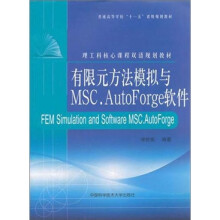Preface
Chapter 1 Overview
1.1 Where This Material Fits
1.2 What Does a Finite Element Look Like
1.3 The FEM Analysis Process
1.4 Interpretations of the Finite Element Method
1.5 Historical Sketch and Bibliography
1.6 Review of Matrix Algebra
1.7 Spring Element
Chapter 2 Bar and Beam Elements
2.1 Linear Static Analysis
2.2 Bar Element
2.3 Beam Element
Chapter 3 Two-Dimensional Problems
3.1 Review of the Basic Theory
3.2 Finite Elements for 2-D Problems
Chapter 4 FE Modeling and Solution Techniques
4.1 Symmetry
4.2 Substructures (Superelements)
4.3 Equation Solving
4.4 Nature of Finite Element Solutions
4.5 Convergence of FE Solutions
Chapter 5 Plate and Shell Elements
5.1 Plate Theory
5.2 Thin Plate Theory (Kirchhoff Plate Theory)
5.3 Thick Plate Theory (Mindlin Plate Theory)
5.4 Plate Elements
5.5 Shells and Shell Elements
Chapter 6 Solid Elements for 3-D Problems
6.1 3-D Elasticity Theory
6.2 Finite Element Formulation
6.3 Typical 3-D Solid Elements
Chapter 7 Thermal Analysis
7.1 Temperature Field
7.2 Thermal Stress Analysis
Chapter 8 MSC. AutoForge--An FE Software
8.1 Introduction
8.2 Mechanics of MSC. AutoForge
8.3 Background Information
8.4 Cylinder Compression--A Sample Session
Chapter 9 Guide for a Complex Laboratory
9.1 Background Parameters and Requirements
9.2 Operation Steps
Further Reading

 缺书网
缺书网 扫码进群
扫码进群





